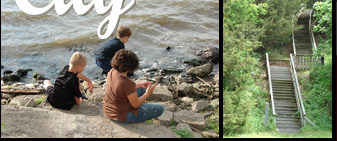Dallas City, IL



Dallas City was first laid out in 1848 by John Finch. It was originally a wild thicket of brush and trees and inhabited by the Sac and Fox Indian tribes. Finch Purchased the land from Israel Atherton in 1836, the first white man known to settle here. Prior to this, Pontoosuc was the name of the entire area and a very large settlement according to the times. When Finch and Rollison, merchants in Pontoosuc, Moved to this area to start businesses here, they were still forced to go to Pontoosuc for their mail because the government would not allow post offices to be located under 5 miles apart. There was a post office at the camp creek area, south-west of the future town run by Silas McKaig's father. When Finch and Rollison heard the McKaig wanted to get out of business, they arranged for him to resign in favor of their taking over this route. In return, they promised to deliver his mail to Camp Creek free for the rest of his life. Thus, “South Bend” got its post office.
The river was the only means of transportation in and out of town. There was a low water rapids between Ft. Madison, IA and Nauvoo, IL (named Commerce at the time) and during the summer many larger boats could not get past them. The main road in and out of town was along the river banks and often muddy and covered with brush. President James Polk and his Vice-President George M Dallas got stranded for a time in the island directly across from the South Bend area. It was decided to name the island after the president and the town after the vice-president. Abraham Lincoln also visited this area in 1858 when he was running for President of the United States. The American Legion tried to put Memorial plaques on two large granite stones they bought and had moved to the Riverfront Park at the end of Oak St. honoring the three men in the 1930's, but only the Lincoln stone got a bronze plaque. The second stone was intended to honor Polk and Dallas. The name Dallas “City” came after the city planners got enough signers on a petition sent around for signatures of people who had come many miles to hear Mr. Lincoln.
Henry Farnwald Black came down river in 1857 with a large load of logs he intended to sell at Ft. Madison or Keokuk, but after checking out the Dallas City area, decided to start a lumber business of his own and also a planeing mill to go along with it. Mr. Rollison started a flour mill along the river and a distillery. Dud Butler, future editor of the Dallas City Review paper stated there was continual procession of boats of all kinds going out and coming to the river landing and horse and wagons waiting in long lines to buy and sell wares or get their wheat ground.
Also, around this time, the front street of the town was a great place for the thirsty river boat lumbers crew to “relax and have a good time”. Sort of an old western Dodge City. The other citizens of the town closed their blinds and locked their doors when the river boats crews landed in town.
When the Keokuk Dam was built in 1912, it eliminated the problem of low water, but also covered a large area of the waterfront upstream.
The Q.B.&Q. RR came into existence in the late 1860's and the Santa Fe in the 1880's. Telephones came into existence in the late 1900's, electricity in 1907, and city water system around that time also. The necessity of a sewer system came into being in the 1930's.
In 1890, the “City Fathers” realizing the importance of employment if the town was to grow, gave Louis Burg $5,000 and a large parcel of land on the east side of Dallas City to bring his buggy factory to town. A button factory was established in the late 1890's for further employment. Our unique three story High School building was built in 1895, largely with the German immigrants influence of a “Castle on Der Rhine” as Louis Burg Stated.
With this beginning, Dallas City has evolved into a pretty and peaceful little town of around 1,000 people on the banks of the Mississippi River.
History Written By: Connie Ferrill


